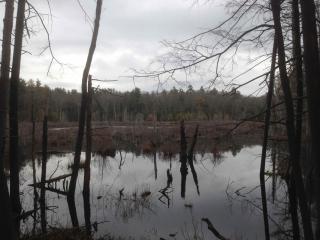Wetlands Protection in Boxford

BEFORE Starting a Project Contact the Conservation Office!
A large percentage of Boxford homeowners have wetland resource areas on or near their property. If you plan to do any work in a wetland resource area, within the 100 foot buffer zone of a wetland, or within 200 feet of a river, such as:
- Tree removal or other vegetation clearing
- Grading or excavation
- New landscaping
- Construction, additions, etc.
...or any other activity that might alter wetlands or their buffer zones, you must contact the Commission. Do not assume your contractor will automatically pull all necessary permits. If you do need approval, professional staff are ready to answer your questions and help guide you through the application process.
The complexity of the approval process is commensurate with the type and scale of the activity proposed. Minor projects such as removing a few trees may be handled by a simple approval letter, while a large construction project may require a detailed application and evaluation during one or more public hearings.
Wetland “Do’s and Don’ts”
Many activities near wetland resource areas are allowed and do not require Commission approval, including:
- Mowing an existing lawn
- Working in an existing garden
- Pruning and maintaining existing landscaping
- Planting native vegetation
- Hiking, horseback riding, and other passive recreation
- Cleaning out culverts
Other activities are prohibited in wetland resource areas or buffer zones and are subject to fines (some are allowed, but only with a permit):
- Dumping yard waste such as leaves, grass, etc, or other waste products, including manure
- Constructing animal paddocks
- Dumping dirt or other fill
- Draining or pumping water from a wetland, pond or stream
- Building dams or removing beaver dams
Wetlands function best in a natural state. Do not clear them or “clean them up.” Wildlife often thrives in areas with brush piles, rotting logs, and other things some people might consider “untidy.”
What are Wetlands?
“Wetland resource areas” include the commonly known cattail marsh and open water pond, also rivers that generally flow throughout the year, 200-foot riverfront areas which border rivers on both sides, intermittent streams that dry up during part of the year, low-lying flood plains and vernal (springtime) pools. These areas (except riverfront areas) are surrounded by “buffer zones” – 100 foot wide protective zones around wetlands that protect wetlands from human impacts and provide valuable wildlife habitat.
Why are Wetlands Important?
Wetland resource areas provide critical habitat to wildlife and help maintain the aesthetic beauty of our town. They also provide priceless yet “free” services including:
- Drinking water purification
- Groundwater recharge
- Flood control
- Pollution prevention
All Boxford residents benefit from these services because of our reliance on natural settings for property values, wells for drinking water, and septic systems for waste disposal. The Conservation Commission is responsible for protecting these areas, by enforcing state and local wetlands protection laws and regulations.
Limiting Chemical Use and Conserving Water: A Few Words About Lawn Care
Do you know what comes out of your weed killer bottle or the lawn care spray truck? Chemicals – many of which can be harmful to humans, pets, wildlife and plants. They do a lot more than make your lawn green.
The Commission recommends that you avoid using chemicals anywhere on your property due to the potential hazards that they pose to your drinking water, your children, and your pets. If you live next to a pond, fertilizer use can also cause excessive plant growth in the water, harming both the environment and aesthetics. Many natural lawn care alternatives are readily available – and they work. Call our office for details.
The Commission also recommends you use water responsibly when maintaining your lawn or other landscaping. Excessive lawn watering contributes to severe low-flow conditions in streams and rivers in all but the wettest years. Call our office for ideas and resources that will help you reduce your water use while still maintaining a beautiful yard.

